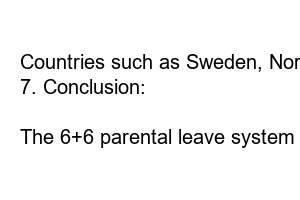6+6 부모육아휴직제
Title: Revolutionizing Parental Leave: The 6+6 System
Introduction:
Parental leave policies around the world have seen significant progress in recent years, recognizing the importance of equal involvement and bonding between parents and newborns. One such innovative approach is the 6+6 parental leave system, which offers a unique and flexible approach to balancing work and family life. In this blog post, we will delve into the details, benefits, and frequently asked questions about this groundbreaking leave system.
1. What is the 6+6 Parental Leave System?
The 6+6 parental leave system allows parents to split their total parental leave entitlement into two separate periods: six months immediately following the birth or adoption of a child, and an additional six months until the child turns seven.
2. Why is Flexibility Key?
Flexibility is at the core of the 6+6 parental leave system, granting parents the freedom to decide when and how they want to take their leave. Whether they choose to take the full six months consecutively or spread it out over time, this system helps meet the diverse needs of individual families.
3. Benefits for Parents and Children:
The 6+6 system provides prolonged and uninterrupted time for parents to bond with their newborns or newly adopted children. This extended leave allows for the establishment of vital attachments and nurturing relationships, enhancing the overall well-being and development of the child.
4. Positive Impact on Gender Equality:
One of the significant benefits of the 6+6 system is its potential impact on gender equality. By encouraging both parents to take an active role in parenting, it helps break down traditional gender roles and promotes shared responsibilities. This has a ripple effect on workplace gender dynamics, leading to more opportunities for women in their careers.
5. Employer Incentives and Supportive Workplace Culture:
To successfully implement the 6+6 system, employers play a crucial role. By offering supportive policies such as flexible work arrangements and a family-friendly work environment, businesses can attract and retain talented employees. It also positions them positively within the community as socially responsible entities.
6. Global Success Stories:
Countries such as Sweden, Norway, and Iceland have embraced variations of the 6+6 system, reaping numerous benefits. These nations have witnessed increased gender equality, higher female workforce participation, improved child well-being, and stronger family bonds.
7. Conclusion:
The 6+6 parental leave system represents a progressive step forward in creating a more balanced and equitable society. It recognizes the importance of parental involvement in a child’s formative years and helps foster a nurturing environment that maximizes the potential of both parents and children. By prioritizing flexibility, workplaces can actively contribute to the well-being and success of families. Embracing the 6+6 system has the potential to revolutionize traditional notions of parental leave, bringing about lasting positive change.
Summary:
The 6+6 parental leave system offers a flexible approach to parental leave, allowing parents to split their entitlement into two periods. This system promotes bonding, gender equality, and enhanced child development. It relies on supportive workplace policies and has proven successful in various countries. By embracing the 6+6 system, we pave the way for stronger families and a more equitable society.

